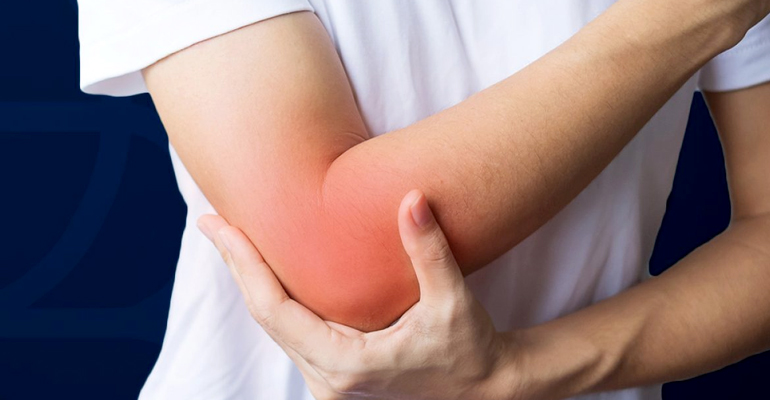-
-
+91-8591556577
-
Tennis Elbow

Tennis Elbow
Tennis Elbow, or lateral epicondylitis, is a common condition caused by overuse or strain on the tendons in the elbow, leading to pain and discomfort. Despite its name, this condition affects not just tennis players but anyone who engages in repetitive arm and wrist movements. Tennis elbow typically develops from activities that involve gripping or twisting actions, such as typing, painting, or even using tools.
What Causes Tennis Elbow?
Tennis elbow occurs when the tendons that connect the forearm muscles to the outside of the elbow become inflamed or damaged. This is often due to repetitive stress on these tendons, which can cause micro-tears and irritation. The most common causes include:
- Overuse: Repetitive wrist and arm motions, especially in sports like tennis, squash, and weightlifting, can lead to tendon strain.
- Work-Related Activities: Jobs that involve frequent wrist extension or forearm rotation, such as carpentry, plumbing, painting, or typing, can also contribute to tennis elbow.
- Poor Technique: Using improper technique or equipment in sports or other activities can increase strain on the tendons, leading to tennis elbow.
- Age: Tennis elbow is more common in adults between the ages of 30 and 50, as tendons naturally weaken with age, making them more susceptible to injury.
Symptoms of Tennis Elbow
The hallmark symptom of tennis elbow is pain and tenderness on the outside of the elbow, which can radiate down the forearm and wrist. Other common symptoms include:
- Pain when gripping objects: Activities like holding a cup, shaking hands, or turning a doorknob may cause discomfort.
- Weakness: The forearm may feel weak, making it difficult to lift or carry objects.
- Stiffness: Some patients may experience elbow stiffness, especially in the morning.
- Worsening Pain with Activity: The pain typically worsens with activities involving wrist extension or gripping, such as lifting, twisting, or repetitive movements.
Diagnosing Tennis Elbow
To diagnose tennis elbow, a physician will perform a physical examination to assess the location of the pain and test the strength and flexibility of the forearm. In some cases, imaging tests such as X-rays, ultrasound, or MRI may be recommended to rule out other potential causes of elbow pain, such as arthritis or a pinched nerve.
Treatment Options for Tennis Elbow
Most cases of tennis elbow can be effectively treated with non-surgical methods. The primary goal of treatment is to reduce pain and inflammation while allowing the tendon to heal. Treatment options include:
- Rest and Activity Modification: Avoiding or modifying activities that cause pain is essential for recovery. Resting the affected arm and allowing the tendon to heal can significantly reduce symptoms.
- Ice Therapy: Applying ice to the affected area for 15-20 minutes several times a day can help reduce inflammation and relieve pain.
- Nonsteroidal Anti-Inflammatory Drugs (NSAIDs): Medications like ibuprofen or naproxen can help reduce pain and inflammation in the early stages of treatment.
- Physical Therapy: A customized physical therapy program can strengthen the forearm muscles, improve flexibility, and promote healing. Stretching and strengthening exercises for the wrist and forearm are essential for long-term recovery.
- Bracing: Wearing an elbow brace or strap can reduce strain on the tendons and provide support during daily activities or sports.
- Steroid Injections: For more severe cases, corticosteroid injections may be administered to reduce inflammation and pain in the affected tendon.
- Extracorporeal Shockwave Therapy (ESWT): This non-invasive treatment uses sound waves to stimulate healing in the affected tendon and reduce pain. It may be recommended for chronic cases that do not respond to other treatments.
Surgical Options
In rare cases, when non-surgical treatments do not relieve symptoms after 6-12 months, surgery may be considered. Surgical options for tennis elbow include:
- Tendon Release Surgery: The surgeon removes the damaged part of the tendon and reattaches healthy tissue to the bone. This can be done through open surgery or minimally invasive techniques, such as arthroscopy.
- Debridement: The surgeon removes scar tissue or damaged tendon fibers to allow for better healing.
Recovery and Rehabilitation
Recovery from tennis elbow depends on the severity of the condition and the treatment approach. Non-surgical treatments may take several weeks to months to provide relief, while surgery requires a more extended recovery period. Rehabilitation, including physical therapy and gradual return to activity, is essential for preventing re-injury.
- Non-Surgical Recovery: Patients can typically resume normal activities within a few weeks to a few months, depending on the severity of the condition.
- Post-Surgical Recovery: Recovery from surgery may take 3-6 months, and physical therapy plays a crucial role in regaining strength and flexibility.
Preventing Tennis Elbow
To prevent tennis elbow or reduce the risk of recurrence, consider the following strategies:
- Improve Technique: Whether in sports or work, using proper techniques and equipment can reduce strain on the tendons.
- Strengthening Exercises: Strengthening the forearm, wrist, and shoulder muscles can provide better support for the elbow and reduce the risk of injury.
- Stretching: Regular stretching of the forearm muscles can improve flexibility and reduce tension on the tendons.
- Gradual Increase in Activity: Avoid overloading the tendons by gradually increasing the intensity of activities, especially in sports like tennis or weightlifting.
- Ergonomic Adjustments: In the workplace, ensure that tools, equipment, and workstations are designed to minimize strain on the arm and wrist.
